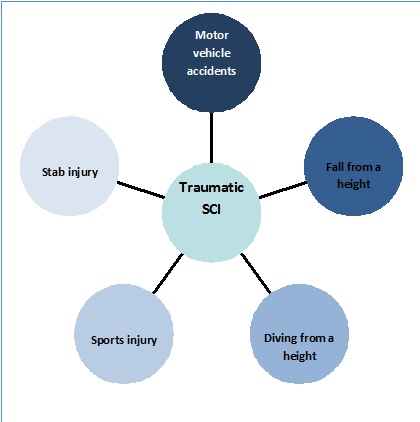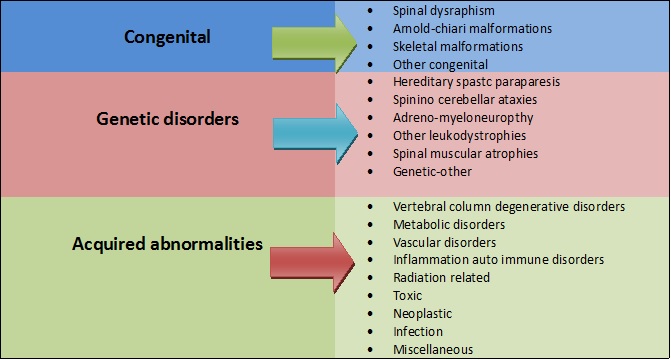Overview of Spinal Cord Injuries
- Please do not edit unless you are involved in this project, but please come back in the near future to check out new information!!
- If you would like to get involved in this project and earn accreditation for your contributions, [[[Special:Contact|please get in touch]]]!
Original Editor - Kudzanayi Ronald Muzenda
Top Contributors - Naomi O'Reilly, Kudzanayi Ronald Muzenda, Kim Jackson, Admin, Tarina van der Stockt, Rucha Gadgil, Jess Bell, Lucinda hampton and Ewa Jaraczewska
What is a Spinal Cord Injury [edit | edit source]
Spinal Cord Injury (SCI) is a sudden onset disruption to the neuronal tisue within the spinal canal resulting in spinal cord damage as a result trauma, disease or degeneration. [1][2] Injuries to the spinal cord are complex, and each individuals injury is unique in terms of the functions affected. It can present as either an upper motor neurone lesion or lower motor neurone lesion with varying loss of motor, sensory and autonomic function, either temporary or permanent depending on the level and type of injury to the Spinal Cord.[2][3] Classification of Spinal Cord Injury is conducted based on the degree of sparing of movement and sensation below the level of the Injury using the ASIA Impairment Scale. [4]
Paraplegia refers to impairment or loss of motor, sensory or autonomic function in areas of the body served by the thoracic, lumbar or sacral segments of the spinal cord. Depending on the level of the injury trunk, pelvic organs and lower limbs may be involved with upper limb function preserved.[1]
Tetraplegia, sometimes referred to as quadriplegia, refers to impairment or loss of motor, sensory or autonomic function in areas of the body served by the cervical segments of the spinal cord. This results in impairment in upper and lower limbs, trunk and pelvic organs with respiratory function impaired in those with high cervical injuries.[1]Clinically Relevant Anatomy[edit | edit source]
Th spinal column is comprised of 33 vertebra that provide support and protection for the spinal cord. The spinal cord is the major conduit through which motor and sensory information travels between brain and body. The spinal cord contains longitudinally oriented spinal tracts (white matter) surrounding central areas (gray matter) where most spinal neuronal cell bodies are located.
The gray matter is organized into segments comprising sensory and motor neurons. Axons from spinal sensory neurons enter and axons from motor neurons leave the spinal cord via segmental nerves or roots. The roots are numbered and named according to the foramina through which they enter/exit the vertebral column. Each root receives sensory information from skin areas called dermatomes. Similarly, each root innervates a group of muscles called a myotome.
The spinal column is divided into four regions: Cervical (7 vertebrae), thoracic (12 vertebrae), lumbar (5 vertebrae) and sacral (5 vertebrae). [5]
Epidemiology / Etiology[edit | edit source]
Causes of SCI can either be traumatic or non traumatic
Traumatic causes of Spinal Cord Injuries [6][edit | edit source]
The diagram below shows the traumatic causes of of SCI
Non-traumatic causes of Spinal cord injuries[7][edit | edit source]
The table below shows a summary of non- traumatic causes of SCI injuries
Management[edit | edit source]
Conservative Management[edit | edit source]
Surgical Management[edit | edit source]
Types of Spinal Cord injuries[edit | edit source]
Paraplegia
Rehabilitation of Spinal Cord injuries[edit | edit source]
References[edit | edit source]
- ↑ 1.0 1.1 1.2 Stack E, Stokes M, editors. Physical Management for Neurological Conditions. Elsevier Churchill Livingstone; 2012.
- ↑ 2.0 2.1 Harvey L. Management of Spinal Cord Injuries: A Guide for Physiotherapists. Elsevier Health Sciences; 2008 Jan 10.
- ↑ Tymianski, D., Sarro, A. Green, T. (2012). Navigating Neuroscience Nursing: A Canadian Perspective. 1st Ed. Pappin Communications, Pembroke, Ontario
- ↑ Kirshblum SC, Burns SP, Biering-Sorensen F, Donovan W, Graves DE, Jha A et al. International standards for neurological classification of spinal cord injury (revised 2011). J Spinal Cord Med 2011; 34: 535-546
- ↑ Francisco de Assis Aquino Gondim et al., Topographic and Functional Anatomy of the Spinal Cord, Medshape, 2015
- ↑ Ackery A, Tator C, Krassioukov A. A global perspective on spinal cord injury epidemiology. J Neurotrauma 2004; 21: 1355-1370
- ↑ Biering-Sørensen F, Charlifue S, DeVivo M, Noonan V, Post M, Stripling T, Wing P. International Spinal Cord Injury Data Sets. Spinal Cord. 2006 Sep;44(9):530-4.).








